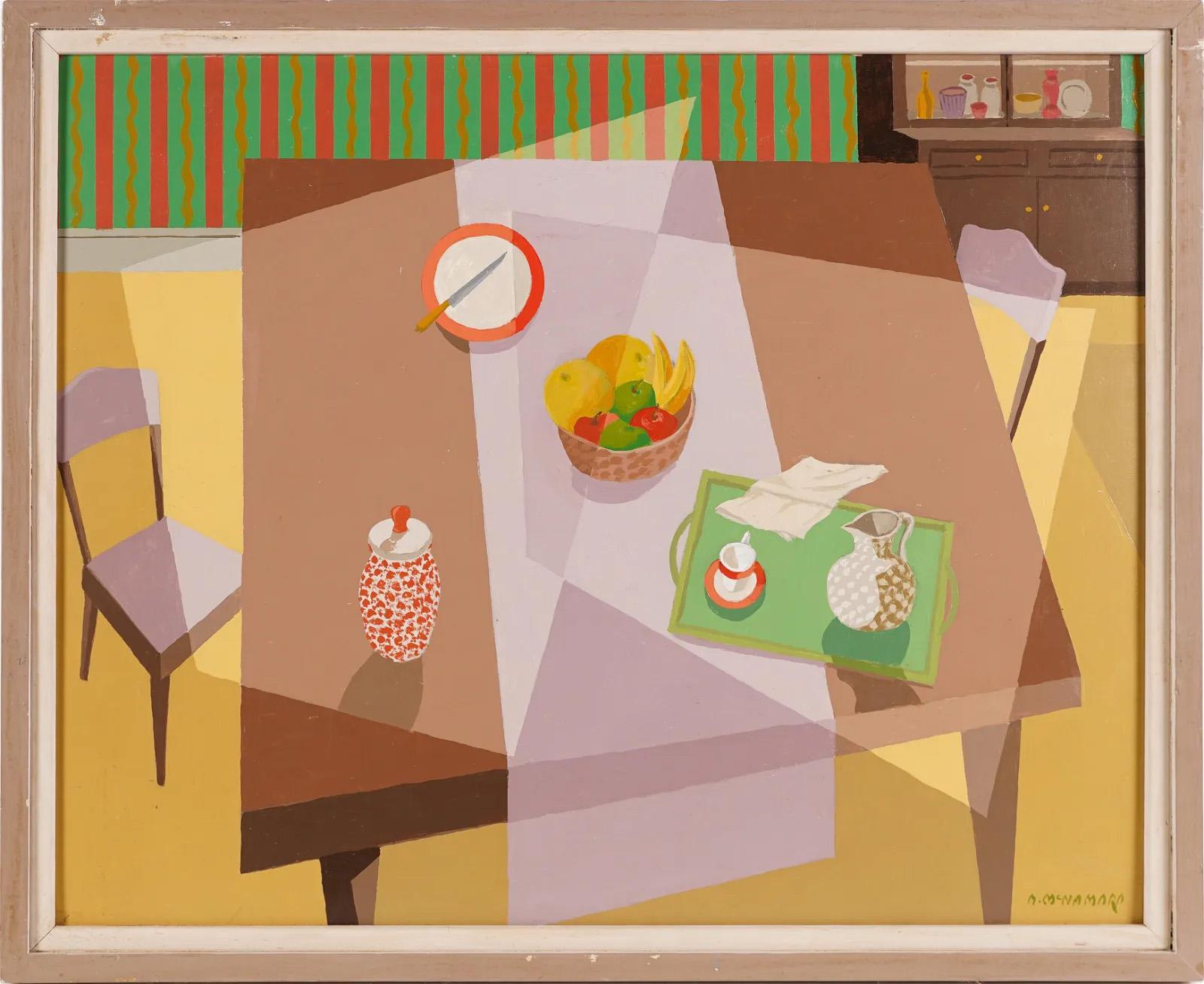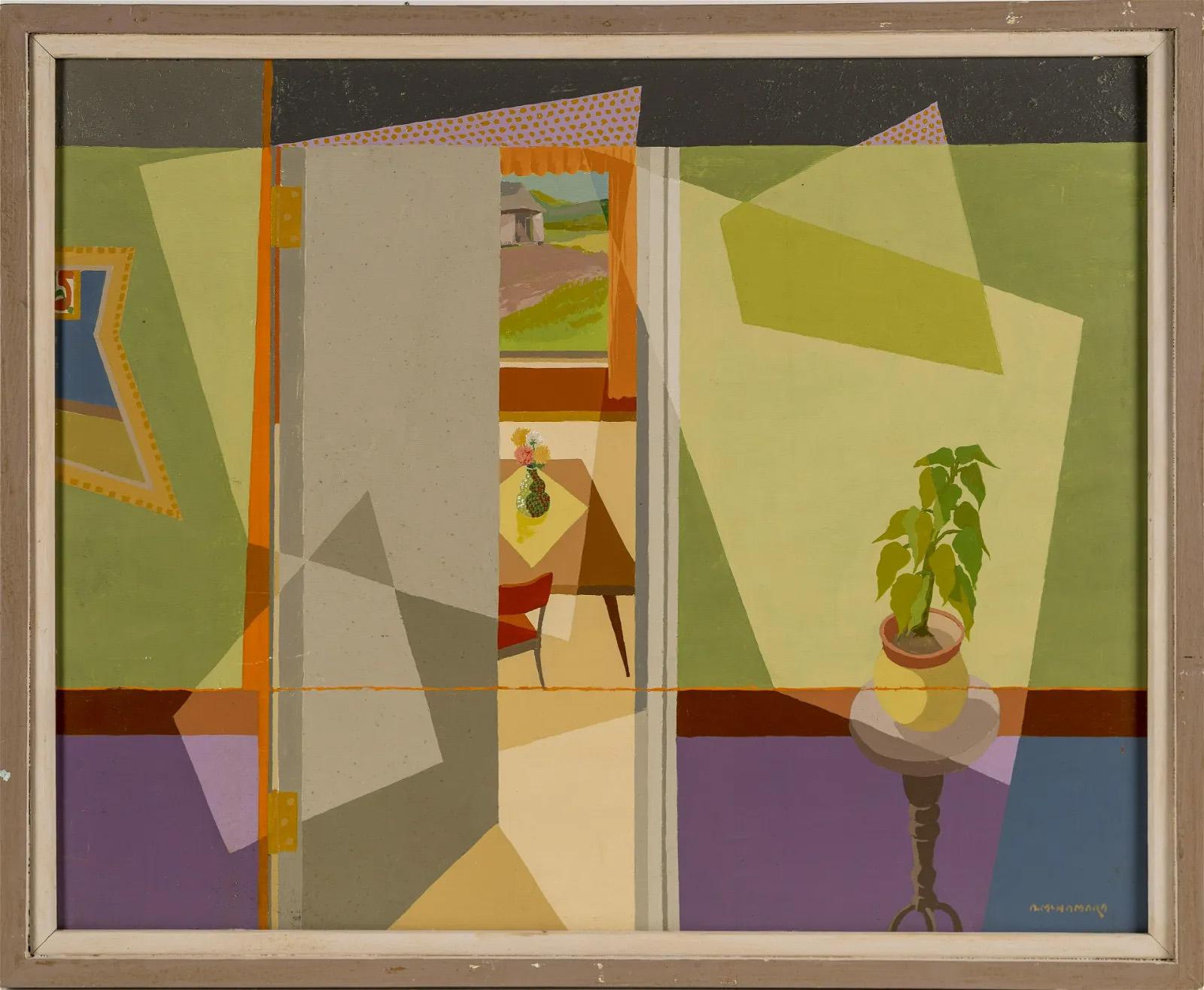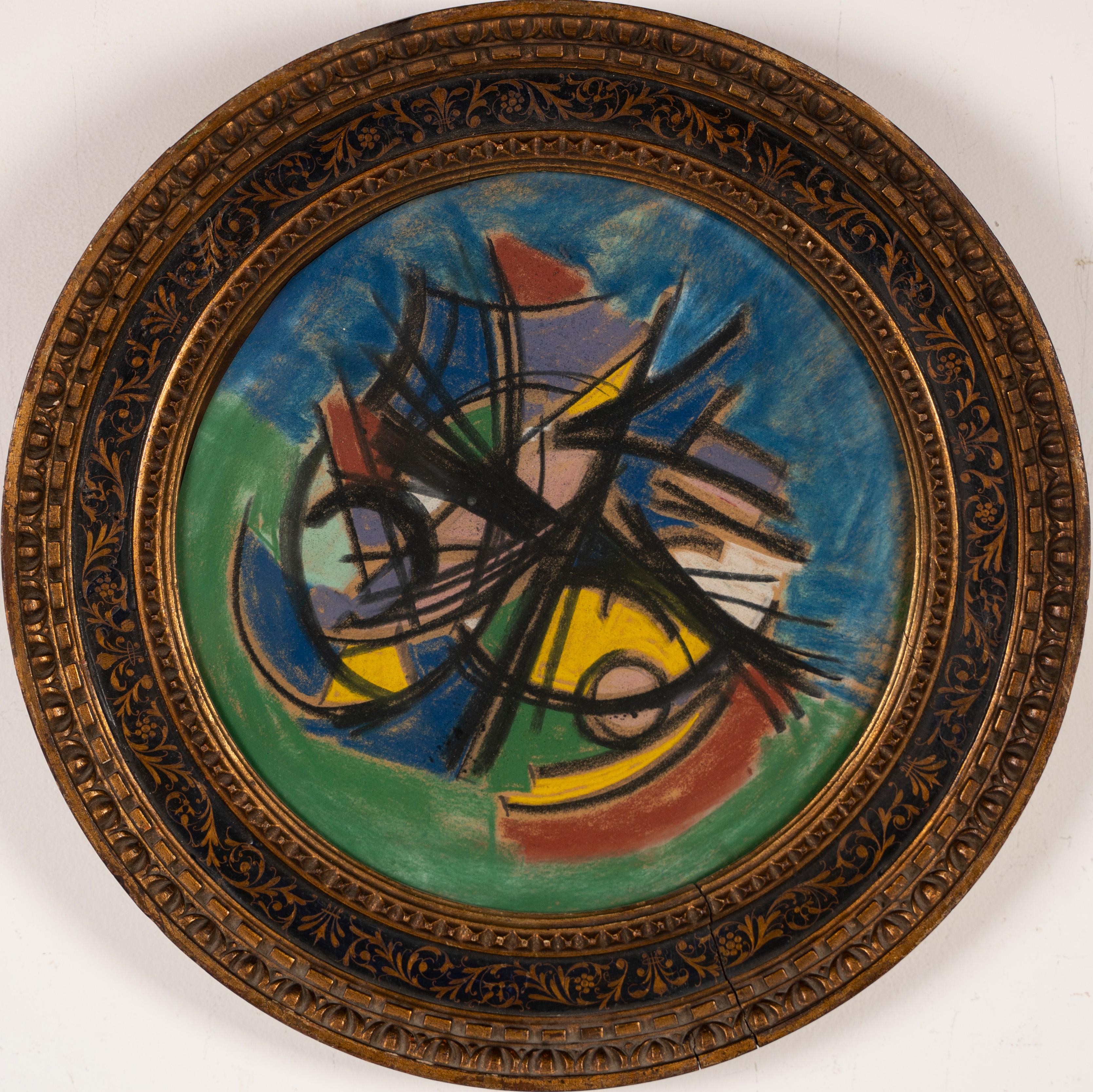Items Similar to "Mums" William S. Schwartz, Yellow Flowers, Cubist, Modern Still Life
Want more images or videos?
Request additional images or videos from the seller
1 of 6
William S. Schwartz"Mums" William S. Schwartz, Yellow Flowers, Cubist, Modern Still Lifecirca 1950
circa 1950
About the Item
William S. Schwartz
Still Life with Yellow Mums, circa 1950
Signed lower right
Oil on canvas
20 x 16 inches
Provenance:
Private Collection, Massachusetts
William Schwartz was born in Smorgon, Russia, in 1896, one of nine children in a poor family. He studied art at an early age, earning a scholarship at the Vilna Art School in Russia, 1908–12. He immigrated to the United States at age 17 in 1913, living in New York with his sister for eight months and then moving to Omaha, Nebraska, to live with his brother in 1915. Working as a house painter, he turned his attention to art, studying briefly with J. Laurie Wallace at the Kellom School in Omaha before moving to Chicago. He entered the School of the Art Institute of Chicago (SAIC) in 1916, studying with Ivan Trutnev and Karl A. Buehr, and graduating with honors in life drawing, portraiture, and painting in 1917. He supported himself as a tenor singer in vaudeville, concerts, and opera and received favorable reviews, but he chose to pursue painting instead of singing. His circle of artist friends included important Chicago modernists Aaron Bohrod, Malvin and Ivan Albright, Archibald Motley Jr., and Anthony Angarola. Angarola and Schwartz shared a studio for several years. Schwartz was given a solo exhibition at the Art Institute in 1926—a major accomplishment for 30-year-old artist—his first of three solo exhibitions there. It launched his successful career.
Schwartz established his own style of modernism, influenced by European modernists and American painter Arthur B. Davies. In the catalogue for a second solo show at the Art Institute in 1929, critic J. Z. Jacobsen praised Schwarz’s “powerful and rhythmic lithographs,” and observed that, “Schwartz is also a singer of note, and with this in mind one can more fully appreciate the weird harmonies and swaying movement of his creations in the realm of visual art.” With his use of bold design and flat color influenced by Gauguin and the stark, Fauve colors of Matisse, Schwartz’s works often challenged audiences. Although contemporary writers made efforts to define him as a romanticist rather than an American scene painter, his blend of naturalism and cubism—as seen in Village Number One and Gas Factory, Chicago, for examples—and especially his choice of everyday subject matter suggest an affinity with American scene school. He combined personal allegories and histories with an appreciation of industry and technology.
During the Depression, Schwartz was supported by the Federal Art Project. In 1933, he painted a mural titled Mining for the Century of Progress Exposition; in 1935, he produced a mural entitled Chicago for the Cook County Nurses’ Home, and one called American Musicians for the Glencoe Public Library. He was awarded WPA commissions, and completed murals for Illinois post offices in Fairfield, Eldorado, and Pittsfield. His Mural Study, 1935, for the post office in Pittsfield, shows his approach to constructing a scene that is both decorative and descriptive. Its bold colors and dramatic sky balance the grand span of the bridge and wide river below with a riverboat gliding below it. Family Picnic echoes this river view, situating a motley group of picnickers in the foreground. Schwartz used high-keyed colors and cubist-derived angular shapes to fill in the broad, curved hills on the horizon.
- Creator:William S. Schwartz (1896-1977, American, Russian)
- Creation Year:circa 1950
- Dimensions:Height: 29 in (73.66 cm)Width: 22 in (55.88 cm)
- Medium:
- Movement & Style:
- Period:
- Condition:
- Gallery Location:New York, NY
- Reference Number:1stDibs: LU1841213907982
About the Seller
5.0
Platinum Seller
These expertly vetted sellers are 1stDibs' most experienced sellers and are rated highest by our customers.
Established in 2021
1stDibs seller since 2022
59 sales on 1stDibs
Typical response time: 1 hour
- ShippingRetrieving quote...Ships From: New York, NY
- Return PolicyA return for this item may be initiated within 3 days of delivery.
More From This SellerView All
- "Nature morte" Bela de Kristo, Mid-century Cubist Still Life Abstract CelloBy Bela De KristoLocated in New York, NYBela de Kristo Nature morte, circa 1956 Signed lower right Oil on board 19 5/8 x 11 3/4 inches Provenance: Alexander Kahan Fine Arts, New York Private ...Category
1950s Cubist Still-life Paintings
MaterialsOil, Board
- "Candelabra, " Edward Millman, Colorful Abstract Expressionist Still LifeLocated in New York, NYEdward Millman (1907 - 1964) Candelabra, 1962 Signed lower right; titled and dated on the reverse Oil on canvas 41 3/4 x 31 1/2 inches Provenance: The ...Category
1960s Abstract Abstract Paintings
MaterialsCanvas, Oil
- "Still Life of Fruit, " Albert Swinden, American Abstract Association, AAABy Albert SwindenLocated in New York, NYAlbert Swinden (1901 - 1961) Still Life of Fruit, 1937 Oil on canvas 18 x 30 inches Provenance: Graham Gallery, New York Albert Swinden (1901–1961) was an English-born American abstract painter. He was one of the founders of the American Abstract Artists, and he created significant murals as part of the Federal Art Project. Albert Swinden was born in Birmingham, England in 1901. When he was seven, he moved with his family to Canada, and in 1919 he immigrated to the United States. He lived in Chicago, where he studied for about a year and a half at the Art Institute. He then relocated to New York City, where his art education continued briefly at the National Academy of Design. He soon changed schools again, to the Art Students League, which he attended from 1930 to 1934. He studied with Hans Hofmann and gained an appreciation for Synthetic Cubism and Neoplasticism. According to painter and printmaker George McNeil, Swinden "could have influenced Hofmann ... He was working with very, very simple planes, not in this sort of Cubistic manner. Swinden was working synthetically at this time." While still a student, Swinden began teaching at the Art Students League, in 1932. Swinden married Rebecca Palter (1912–1998), from New York. Their daughter, Alice Swinden Carter, also became an artist. Carter, who attended the School of the Museum of Fine Arts, Boston, received an award from the Institute of Contemporary Art, Boston for her large sculptures. Swinden was hired for the Federal Art Project (FAP) of the Works Progress Administration (WPA), and he is best known for the murals which he painted as part of that project. In 1935, New York City Mayor Fiorello La Guardia attended the opening of the inaugural exhibit at the Federal Art Project Gallery, accompanied by Audrey McMahon, New York regional director for the Works Progress Administration/Federal Art Project. Among the works on display was Abstraction, a sketch by Swinden; it was the design for a mural planned for the College of the City of New York. A newspaper account described it as consisting of "brightly colored T-squares, triangles and rulers in horizontal, vertical and diagonal positions". La Guardia asked what it was, and upon being told it was a mural design, he said he didn't know what it depicted. Someone joked that it could be a map of Manhattan. The displeased mayor stated that "if that's art, I belong to Tammany Hall." (Tammany Hall, which the Republican mayor referenced, was the New York Democratic Party political society.) Fearing that the mayor's negative attitude could jeopardize the future of abstract art within the Federal Art Project, McMahon dispatched an assistant to summon an artist who could speak to the mayor in defense of abstraction. The assistant returned with Arshile Gorky. Swinden played an important role in the founding of the American Abstract Artists. In 1935, he met with three friends, Rosalind Bengelsdorf, her future husband Byron Browne, and Ibram Lassaw, with the goal of exhibiting together. The group grew and started meeting in Swinden's studio, which adjoined those of Balcomb and Gertrude Greene...Category
1930s Modern Still-life Paintings
MaterialsCanvas, Oil
- "Floral Bouquet Still Life, " Everett Lloyd Bryant, American ImpressionismBy Everett Lloyd BryantLocated in New York, NYEverett Lloyd Bryant (1864 - 1945) Floral Bouquet Still Life Oil on canvas 30 x 25 inches Signed lower right; signed on the reverse and on stretc...Category
Early 20th Century American Impressionist Still-life Paintings
MaterialsCanvas, Oil
- "Still Life with Pink Ewer and Sheet Music" Nicholas Alden Brooks, Trompe L'oeilBy Nicholas Alden BrooksLocated in New York, NYNicholas Alden Brooks Still Life with Pink Ewer and Sheet Music, 1891 Signed and dated lower right Oil on canvas 20 1/8 x 16 inches Considerable mystery surrounds the name Nicholas Alden Brooks. Other than having been active in New York City between 1880 and 1904, very little is known about the artist. There are no records of any art societies showing him as a member or his having participated in any exhibits. The name Brooks, in fact, could possibly be a pseudonym for Robert Fullington, whose name appears on theatrical memorabilia in Brookss trompe loeil still-life paintings. William Harnett...Category
1890s Realist Still-life Paintings
MaterialsCanvas, Oil
- "Ethnographic Still Life, " Edith Kramer, African Mask and Shofar, Art TherapyBy Edith KramerLocated in New York, NYEdith Kramer (1916 - 2014) Still Life with Mask, n.d. Oil on canvas 26 x 20 inches Signed and titled on the stretcher Provenance: Estate of the artist Kramer was born in Vienna, Austria-Hungary in 1916. At age 13 Kramer began art lessons with Friedl Dicker. Dicker was graduate of the Bauhaus in Weimar, Germany and was an artist and art teacher of note. Kramer studied drawing, sculpture and painting, and was influenced by the method for teaching art developed by Bauhaus artist Johannes Itten. It was in 1934 after Kramer graduated from Realgymnasium that she, then 18, followed Dicker to Prague to continue to study under her. During this time in Prague, Kramer witnessed the therapeutic impact of art when she assisted Dicker in teaching art to the children of political refugees. With the threat of Nazi invasion looming, Kramer took refuge in America in 1938. In New York City, she worked for three years teaching sculpture at a progressive school called the Little Red School House. During World War II Kramer worked as a machinist at a tool and die shop in the Soho district of New York City. She stayed after her shift to draw the other workers in their industrial setting. These works were rendered in the social realist style. In 1947 Kramer visited some of the earliest known artwork, in the caves at Lascaux. Kramer spoke of these cave paintings as an example of the universal language of art. At the age of 33 she returned to New York City, with hopes of making a living as an artist. Still in her 33rd year, Kramer was offered a job at Wiltwyck School for Boys, a school and residential treatment facility for children with behavioral and emotional needs. This job was arranged for her by psychoanalyst and board member at Wiltwyck, Dr. Viola Bernard. Dr. Bernard gave Kramer the title, "Art Therapist," noting that few teachers were willing to work with such challenging students. It was here that Kramer worked with disturbed boys, ages 8 through 13, for the following seven years. Raised in a family which was interested in psychoanalytic theory, Kramer herself became a follower of Sigmund Freud. Kramer especially believed in the concept of sublimation. Freudian theory describes sublimation as a process in which primitive urges coming from the id are transformed into socially productive activities that lead to gratification of the original urge. Kramer's training was in art, art education and psychoanalytically informed psychotherapy. Kramer believed sublimation to be one of the most vital goals of art therapy...Category
20th Century American Modern Still-life Paintings
MaterialsCanvas, Oil
You May Also Like
- The Silk Hat oil on canvas by Arna BrittinLocated in Hudson, NYAn exceptional cubist oil painting by Arna Brittin. The painting retains its original frame, and was exhibited at the Minneapolis Institute of Art Annual Exhibition in 1927. The Si...Category
1920s Cubist Still-life Paintings
MaterialsCanvas, Oil
- Large Antique American Modernist Signed Cubist Still Life Original Oil PaintingLocated in Buffalo, NYOil on board. Signed. Framed. Image size, 24H x 30LCategory
1960s Cubist Still-life Paintings
MaterialsCanvas, Oil
- Large Antique American Modernist Signed Cubist Still Life Original Oil PaintingLocated in Buffalo, NYOil on board. Signed. Framed. Image size, 23 1/2H x 29 1/2LCategory
1960s Cubist Still-life Paintings
MaterialsOil, Canvas
- Silhouette. 1997, oil on canvas, 57x69 cmBy Janis ZemitisLocated in Riga, LVSilhouette. 1997, oil on canvas, 57x69 cm Abstract still life with guitar in red colors In 1958 he graduated from the Riga Art School of J. Rosenthal, in 1964 Art...Category
1990s Cubist Still-life Paintings
MaterialsCanvas, Oil
- Antique American School New York City Cubist Abstract Framed Original PaintingLocated in Buffalo, NYVintage American modernist cubist abstract painting. Watercolor gouache and pastel on board. Unsigned. Framed. Image size, 11"L x 11"H.Category
1940s Cubist Abstract Paintings
MaterialsCanvas, Oil
- John Hatch American Cubist Abstract Oil Painting 1950's Mid C Black and WhiteBy John W. HatchLocated in Buffalo, NYAn original oil on board painting by American modernist John W. Hatch. This incredible cubist painting was created in the 1950's. Estate stamped on the reverse. The painting com...Category
1950s Cubist Abstract Paintings
MaterialsCanvas, Oil



